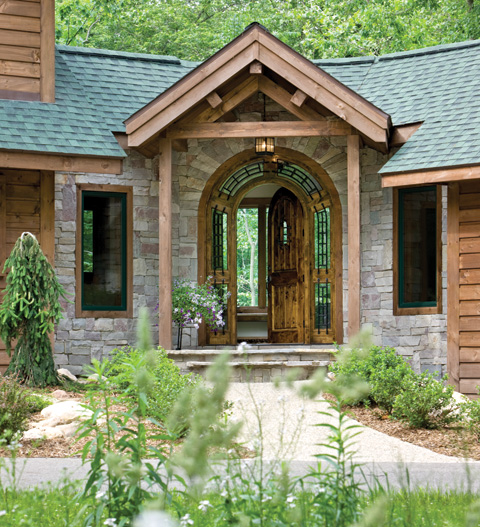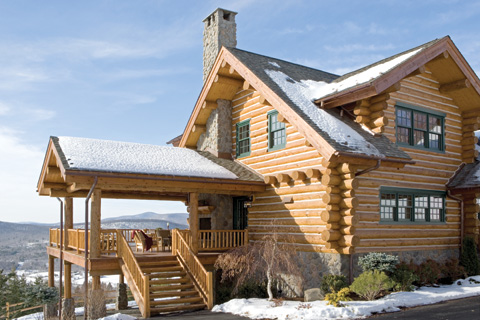Seasons come and go. The sun glares and sets. Rain, wind, and winter snow are continuing possibilities. Since the elements take their toll on any structure, consistent maintenance means good looks, savings in time and money, and fewer headaches for the log or timber homeowner. But questions persist as to the best approach.
“I like to look at it as being an investment and not a cost,” observes Tony Huddleston, senior vice president of sales and operations at Perma-Chink Systems, Inc. “After all, I am often surprised how much a well-maintained log home appreciates in value rather than depreciates. Log home maintenance is a series of basic steps that should be done on a schedule in order to prevent more expensive maintenance later on in your home’s life. Plus, if it is done on a schedule it makes planning easier, less time consuming, and less expensive.”
Those steps are straightforward. Wash the home annually to remove pollen, dirt, and debris. Any issues with the condition of the exterior may be more easily spotted with a clean surface. Make sure gutters and downspouts are clear and functional so that water doesn’t have a chance to build up and infiltrate the structure. Moisture is the enemy! Keep bushes, landscaping, and vegetation a reasonable distance from the structure to prevent trapping water and shut down a highway for insects that might otherwise invade. Trim shrubs if they have grown out of control.
Pay particular attention to the west and south walls of the log home to make sure they are intact and free of separations or checking. These exterior surfaces receive more direct sunlight and ultraviolet rays that can break down sealant and finish. Watch for flaking or peeling of the finish or sealant and repair with a light sanding, a bit of stain, and the appropriate resealing. Look for any unsealed areas around windows and doors, where the home may be robbed of energy efficiency, and apply caulk or sealant as needed. Inspect the roof for missing or loose tiles, shingles, or joints and repair as needed.
Call a professional to ensure that chimneys, fireplaces, and heating or air conditioning units are in working order and change any filters regularly. A checklist often serves as a valuable tool, helping the homeowner to complete a comprehensive maintenance plan.

Photo by Roger Wade
“The most basic of all issues is the one pertaining to water repellency,” stresses Barbara Murray of CTA Products Group. “Do not allow the finish to extend beyond its ability to maintain water repellency to the logs. After that, the color may need to be freshened up. Everything fades in the sun! Follow the label instructions for the product you have selected to maintain your logs. Don’t assume that products all go on the same way. Contact your supplier if in doubt.”
Some maintenance worries may be addressed during construction to minimize concerns about issues in the years to come. Choosing products that are appropriate for the home’s location, specifically as it relates to seasonal climate extremes, adds to peace of mind.
“We take great pains to make sure that the installation of such things as doors and windows is done properly,” relates Lynda Tompkins, principal of Timberhaven Log & Timber Homes, “and that includes the caulking and sealing that goes along with it. We also emphasize that insulation is appropriately installed. As you build, the key is to follow manufacturers’ guidelines. Gutters clog, and things freeze. If you fail to maintain a home aesthetically, then its appearance will decline.”
Murray echoes that sentiment. “The worst things that can happen will not occur if your house is properly designed and constructed from the outset. Site selection, deep roof overhangs, and adequate guttering should be of prime consideration,” she offers.
True North Log Homes has recently unveiled its Stain Lock infusion system, a novel approach to managing exterior log and timber maintenance. “Stain Lock is a combination of the rustication process and True North’s proprietary machine-coated stain process,” remarks Marketing Manager Mark Wrightman. “The stain is applied in a climate-controlled environment and infused into the surface of the log to increase stain longevity. The process reduces time, labor, money, and maintenance.”
According to Wrightman, rustication enlivens the wood’s grain and gives it a rustic appearance while also preparing the surface to more readily accept the stain. Application of stain in the controlled environment of the manufacturing facility may also contribute to even distribution and uniformity of color.
The payoff for consistent log and timber home maintenance is years of worry-free enjoyment. Committing preventive time and money consistently yields a solid return on investment.
Photography by Roger Wade Studio

